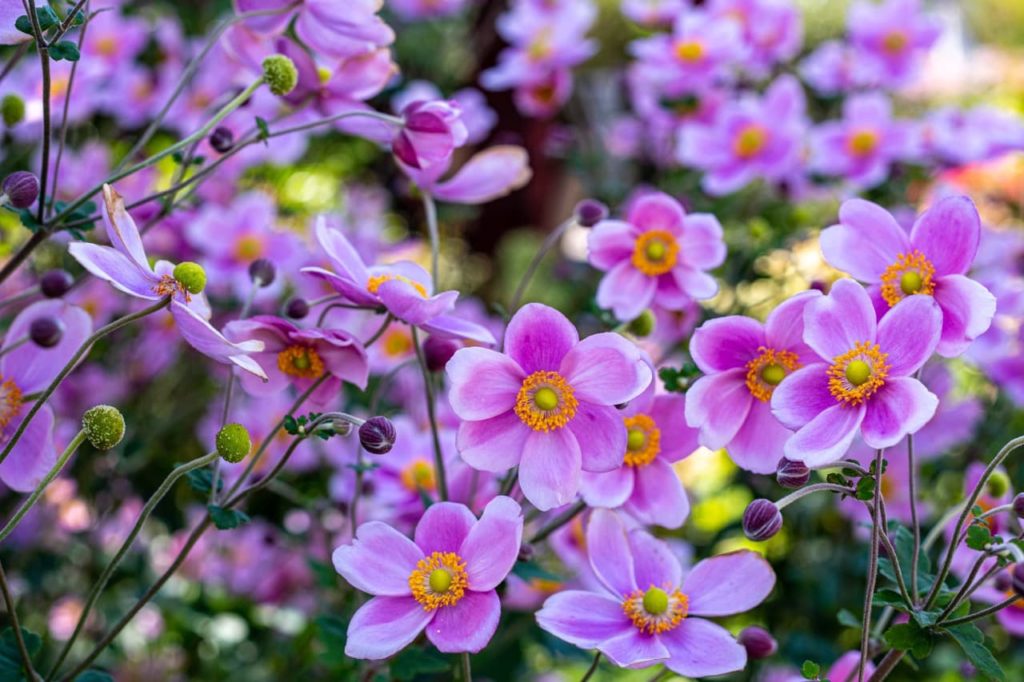Horticulturists Share 15 Summer Flowering Bulbs You Can Plant In Spring


Ed is a horticultural therapist, professional gardener and writer. Ed has a BSc in Occupational Therapy from Coventry University and a Diploma in Social and Therapeutic Horticulture (DipSTH) via Thive, the RHS and Pershore College. Ed runs a community kitchen garden in West Sussex, where he leads horticultural therapy sessions.
Reviewed By PETER LICKORISH

Peter is a Horticulture Lecturer and self-employed Horticulturist, with a passion for diverse areas of the industry - from garden design to the science behind plant growth and propagation. He has completed the Royal Horticultural Society’s Master of Horticulture (MHort) Award and lectures on RHS courses at Bedford College.
Contributions From JONATHAN HART

Jonathan has worked in the industry for as long as he can remember. He’s previously grown gold-medal winning lilies for displays at various flower shows throughout the UK, including at the prestigious RHS Chelsea Flower Show each year, where his nursery has recently been awarded the EH Trophy for their exhibit of cut flowers.

Kate Gould is an award-winning Garden Designer who has built her company, Kate Gould Gardens, over a period of more than 20 years. Kate has won 5 RHS Chelsea Flower Show Gold Medals, including an unprecedented 3 medals for the same garden at the 2022 show. She is a member of the Society of Garden Designers and the British Association of Landscape Industries.
Bulbs are often planted in the autumn to flower in spring, but there are many bulbs that can be planted in spring that will flower and give a stunning display, only a few months later in summer.
“I love the spring because you have so much to do and get ready for the summer, like planting bulbs,” shares Kate Gould.
“I then, in turn, love the summer because I get to look at everything!”
Mostly originating from warmer climates, bulbs tend to need full sun to flower well and can provide some much-needed colour in the garden, when a lot of plants have passed their best.
Bulbs are easy to grow and care for and when discussed often encompass corms, tubers and rhizomes, which are generally planted in a similar way and will be covered in this guide as well.
We list 15 of our favourite bulbs to plant in spring below.
“Many of these plants are on the difficult precipice between hardiness and tenderness,” shares Peter Lickorish, a Master Horticulturist.
“Whilst free-draining soil may be sufficient for them to overwinter outdoors, the combination of cold and wet will be too much for many.
“Also, remember that in containers, raised above the warmth of the soil, the roots and bulbs can be more susceptible to frost damage, especially in smaller pots.”
1) Dahlias

- HARDINESS RATING: H3
- PLANT OUTDOORS: MID-MAY (AFTER LAST FROST)
- FLOWERING MONTHS: JULY – SEPTEMBER
Dahlias are possibly one of the most stunning plants available to grow here in the UK and are often a firm favourite of gardeners.
They can flower, with regular deadheading from mid-summer onwards, often until the first frosts in November.
Available in a huge array of colours and sizes, they are equally happy when grown in a pot or container or directly in the ground.
They are also very popular to grow as cut flowers, as they often grow on long stems and have a long vase life.
Dahlias originate from Mexico, where they are the country’s national flower.1History. (2019, May 26). National Dahlia Society. Retrieved March 13, 2023, from https://www.dahlia-nds.co.uk/about-dahlias/history/

Hence, it is no surprise that they prefer as much sun as they can get, a south or west-facing and sheltered aspect is ideal.
From classic whites to vibrant pinks, oranges and reds and every colour in between, dahlias are obtainable in a multitude of shapes and sizes.
From simple single varieties, ball and pom pom, to cactus and dinnerplate, which can be as large as their name suggests, there is one to suit every garden, balcony or terrace.
However, beware, as once you’ve grown one dahlia there is a huge temptation to grow more!
2) Gladioli

- HARDINESS RATING: H3
- PLANT OUTDOORS: MARCH – MAY
- FLOWERING MONTHS: JULY – SEPTEMBER
When thinking of summer flowering bulbs, gladioli are often top of the list and for good reason.
Also known as sword lilies due to their slender, pointed foliage, they provide great structure and style in all manner of colours during the summer months.
Grown from corms and planted in spring, they are easy to care for and grow well either directly in the ground or in pots and containers.
Gladioli require full sun to bloom well, but can cope with some shade.
Originating from South Africa they are part of the Iridaceae family and are now grown all over the world.
Gladioli do best in a moist, but well-drained soil and can be left in the ground to overwinter in the south of the UK, but may need to be lifted and stored in colder parts of the country.
3) Lilies

- HARDINESS RATING: VARIES
- PLANT OUTDOORS: SEPTEMBER – APRIL
- FLOWERING MONTHS: JULY – SEPTEMBER
Grown for their large trumpet-shaped flowers and incredible scent, lilies look equally stunning when grown in the ground or in containers.
From pink and white to orange and red, lilies are available to buy in a wide range of colours.
“My favourite bulbs have to be lilies because there are so many different types to suit any garden or vase,” explains Jonathan Hart, Horticulturist from Harts Nursery.
“Double lilies, giant-tree lilies, smaller pot lilies, highly-perfumed oriental lilies, brightly-coloured Asiatic lilies and shade-loving Martagon lilies are all amazing, just to name a few.
“They really are a fantastic addition to the garden for beautiful flowers in the summer.”
Oriental and Asiatic are two of the most commonly grown types here in the UK, often sold as bulbs that can be planted in the autumn or spring.
Both varieties prefer full sun, although oriental lilies grow best in ericaceous soil, whereas Asiatic varieties thrive in alkaline or more neutral soil.
Often grown in pots, they can then be moved to their pride of place when in flower and moved once finished, ready to store in an unheated greenhouse or cold frame over winter.
4) Crocosmia

- HARDINESS RATING: H5
- PLANT OUTDOORS: APRIL – MAY
- FLOWERING MONTHS: JUNE – SEPTEMBER
Crocosmia, or montbretia as they are also known, can provide some much-needed colour in the garden late in the summer, when many plants have gone over.
Available in red, orange and yellow, their graceful flowers contrast spectacularly against their bright green foliage.
Grown from corms, crocosmias originate from South Africa and grow best in a fertile and moist soil in full sun.
Crocosmia will tolerate most soils, but do not like to be allowed to dry completely out which can stunt their growth and limit their flowering potential.
Waterlogging will also cause rotting for these plants.
Crocosmia can spread over time, but clumps can be kept to a manageable size by division, or simply by growing in containers.
5) Polianthes

- HARDINESS RATING: H2
- PLANT OUTDOORS: MID-MAY (AFTER LAST FROST)
- FLOWERING MONTHS: JULY – AUGUST
Polianthes are sometimes known as tuberose and produce elegant white or pink scented flowers during mid to late summer.
Polianthes look great either planted in pots or in drifts in the borders.
Originally from Mexico, they require full sun and a minimum temperature of 15°C and are most suited to being grown in a conservatory or greenhouse or on a sheltered terrace.
Perhaps the most widely grown variety here in the UK is Polianthes tuberosa ‘The Pearl’, with its highly scented double white flowers it really is worth trying.
Classed as H2 hardy, Polianthes tubers can survive cold temperatures, but will not survive being frozen, thus are best lifted and stored over winter.
6) Freesias

- HARDINESS RATING: H2
- PLANT OUTDOORS: APRIL – MAY
- FLOWERING MONTHS: JUNE – SEPTEMBER
Freesias are very popular here in the UK for their use as a cut flower.
Available in colours including purple, orange, yellow and white they look stunning in a vase and are accompanied with a sweet scent.
Grow from corms and originally from South Africa, freesias are not hardy and can be planted either in autumn for growing indoors or spring for growing outdoors.

If planting outside, only plant the corms after the last chance of frost has passed, which is usually late May or June.
Freesias like warm conditions, but must be grown in free-draining compost or else they tend to rot, especially when left in waterlogged or wet soils.
In warmer parts of the UK, the corms can be potentially left in the ground to overwinter if protected by a good layer of mulch, but elsewhere will need to be lifted and stored over the coldest months.
7) Agapanthus

- HARDINESS RATING: VARIES
- PLANT OUTDOORS: MARCH – APRIL
- FLOWERING MONTHS: JUNE – SEPTEMBER
Agapanthus or the African Lily as they are also known, are astonishingly beautiful perennials, which can be either deciduous or evergreen.
Grown for their stunning white, blue or purple flowers which tower above their green foliage on tall straight stems.
Perfect for containers, they can also be grown directly in the ground, but they do require full sun and free-draining soil.
Being drought-tolerant, agapanthus are well suited to gravel and coastal gardens as they can tolerate the salty air, but need to be watered well whilst getting established in their first year.
Deciduous agapanthus are usually the most hardy and can be left in the garden to over winter, however most even green varieties will need to be moved to a greenhouse to ride out the winter.
Available as potted plants or bare roots, they are best planted in spring as the soils warms up.
Agapanthus can cope with a little shade, but if placed in too much shade their flowering can be dramatically reduced.
Agapanthus tend to grow best if their root system is restricted, which is why they can do so well in a container or pot and be moved to a prominent position when looking their best.
8) Calla Lilies

- HARDINESS RATING: H4
- PLANT OUTDOORS: MID-MAY (AFTER LAST FROST)
- FLOWERING MONTHS: JUNE – JULY
The Calla lily, or arum lily, is strangely not an actual lily, but is part of the Zantedeschia genus instead.
Originally from South Africa, they produce exotic looking flowers and come in a wide range of colours and can be grown indoors or outdoors.
Available as rhizomes, these tender plants must be overwintered out of the cold.
Some of the white-flowering Zantedeschia, such as Zantedeschia aethiopica, are more hardy.

Preferring a sunny site, calla lilies will cope with partial shade and need to be shaded from the strongest midday sun, which can scorch them.
They also thrive when their roots are generously moist.
In spring, most calla lilies need to be started off indoors until all risk of frost has past, after which and when the soil has warmed up, they can be grown in the ground or in containers outdoors.
Calla lilies are hungry plants and require a rich fertile soil, a high nitrogen feed in spring and then a high potassium feed, such as a tomato feed, once flowering begins.
9) Begonias

- HARDINESS RATING: VARIES (OFTEN H1B)
- PLANT OUTDOORS: MID-MAY (AFTER LAST FROST)
- FLOWERING MONTHS: JULY – OCTOBER
Begonias can have a bit of a reputation as being a bit old fashioned, but either way they can provide continuous colour throughout the summer, thrive in partial shade and are thus still a popular bedding plant.
Begonias are available as either tuberous or fibrous varieties and being tender are often grown as annuals here in the UK.
Tuberous begonias are available from early spring and require starting off in pots indoors until after all risk of frost has past, after which they can be hardened off before planting outside.
Tuberous begonias are hungry plants and require fertile soil and once planted out, a weekly high potassium feed throughout the summer.
Tuberous varieties are often treated as annuals, however in October once their foliage has begun to die back, they can be cut down to 5cm, and their tubers lifted to store over winter until the following spring.
These can then be divided, to restrict growth and produce more stunning plants.
10) Autumn Crocus

- HARDINESS RATING: H5
- PLANT OUTDOORS: MAY – AUGUST
- FLOWERING MONTHS: AUGUST – OCTOBER
Autumn Crocus, or Colchicum autumnale, is an autumn-flowering plant that, while resembling a true crocus, is actually a member of the Colchicaceae plant family.
It should be planted between May and August and will typically flower 6-8 weeks after planting.
An area that receives full sun or part shade is ideal, though this plant is incredibly hardy.
11) Eucomis

- HARDINESS RATING: H4
- PLANT OUTDOORS: MID-MAY (AFTER LAST FROST)
- FLOWERING MONTHS: JULY – SEPTEMBER
While they might look a little too exotic for the UK, eucomis or ‘Pineapple Lilies’ are actually hardy enough to be planted after the last frost, before flowering throughout summer.
They should flower for years once established and are great for bringing some height to a garden, usually growing around half a metre in height.
Plant them in full sun, keep them well watered and ensure they aren’t crowded out by other plants.
“If mulched well, they can usually be left in the ground over winter,” shares Peter.
12) Nerine

- HARDINESS RATING: VARIES
- PLANT OUTDOORS: APRIL – MAY
- FLOWERING MONTHS: SEPTEMBER – OCTOBER
Nerine is a very late flowering bulb which has been highly hybridised with a high number of species and hybrids available.2Nerine. (n.d.). Pacific Bulb Society. Retrieved March 13, 2023, from https://www.pacificbulbsociety.org/pbswiki/index.php/nerine
They prefer a hot, dry area of the garden that ideally receives full sun.
For plants to bear the maximum number of flowers it’s also recommended to keep the growing medium well-watered during active growth so it doesn’t dry out, but avoid over-watering.
Many types are frost tender and will need winter protection if they are to survive, while plants which last 3 years or more will likely benefit from division or repotting.
13) Jersey Lily

- HARDINESS RATING: H4
- PLANT OUTDOORS: MARCH – APRIL
- FLOWERING MONTHS: SEPTEMBER – OCTOBER
This next choice is actually a member of the same family as Nerines, though its flowers look a little fuller.
It can be cared for in much the same way as other nerine plants, but Amaryllis belladonna is a little hardier than other types and can survive temperatures below freezing.
Their hardiness down to -10°C means that you shouldn’t need to overwinter them indoors in Britain, unless you live in a particularly cold region.
“If you’re undecided between an Amaryllis (Jersey lily) and a Nerine, why not combine the best of both with a x Amarine tubergenii?” asks Peter.
“This is one of my favourite bulbs, with vivid pink flowers in late summer and early autumn.
“It likes its bulb tips to slightly protrude from the soil.”
14) Wild Garlic

- HARDINESS RATING: H7
- PLANT OUTDOORS: OCTOBER – MARCH
- FLOWERING MONTHS: JULY – SEPTEMBER
Wild Garlic can actually be planted any time from late-autumn to early spring.
It has a distinctive smell and prefers the shady and damp conditions found in its native woodland environment.
It would be best placed in a dark garden corner or underneath the shaded canopy of a nearby tree.
It is commonly foraged in the UK, with vivid fields of wild garlic at places like Ilam Park in Derbyshire.3Forage for wild garlic. (n.d.). National Trust. Retrieved March 13, 2023, from https://www.nationaltrust.org.uk/visit/countryside-woodland/places-to-forage-for-wild-garlic
Varieties such as ‘Golden Fleece’ are incredibly beautiful with distinctive yellow-green foliage.
15) Japanese Anemones

- HARDINESS RATING: VARIES
- PLANT OUTDOORS: APRIL – MAY
- FLOWERING MONTHS: JUNE – AUGUST
This last one is technically a herbaceous perennial though it is a relative of anemone bulbs that typically flower in early spring.
It has attractive foliage that grows quite tall and produces beautiful white or pink flowers in the summer months.
Japanese Anemones prefer areas of the garden that are fairly moist and which receive part sun – under the canopy of a tree might be an ideal location.
As mentioned there are both early-flowering anemone bulbs and late-flowering perennial varieties, so be careful to choose late-flowering types if you’re looking to plant in early spring.
Japanese Anemones are generally propagated by cuttings rather than seed, so you might need to buy yours from a garden centre or ask for a cutting from a friend.
References
- 1History. (2019, May 26). National Dahlia Society. Retrieved March 13, 2023, from https://www.dahlia-nds.co.uk/about-dahlias/history/
- 2Nerine. (n.d.). Pacific Bulb Society. Retrieved March 13, 2023, from https://www.pacificbulbsociety.org/pbswiki/index.php/nerine
- 3Forage for wild garlic. (n.d.). National Trust. Retrieved March 13, 2023, from https://www.nationaltrust.org.uk/visit/countryside-woodland/places-to-forage-for-wild-garlic
